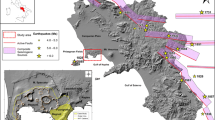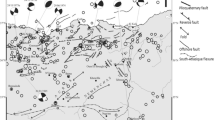Abstract
Probabilistic seismic hazard assessments (PSHA) form the basis for calculating seismic loads in most contemporary seismic provisions in building codes around the world. The current building code of Iraq, which was published in 1997, is currently undergoing a significant engineering update. This study was undertaken in order to support the building code update and to satisfy the need in Iraq for a contemporary assessment of seismic hazard in terms of spectral accelerations. Seismic source characterization largely relies on a newly compiled earthquake catalog since sufficiently detailed information is not available on active faulting in the country even though there are numerous known active faults. There is also a lack of locally recorded strong-motion data. As a result, we make use of attenuation tomography studies in the region to compare local attenuation characteristics with that in other parts of the world where ground-motion prediction equations are available for use in PSHA. For most of the country, the attenuation of 1HzLg waves indicates an attenuation rate that is slower than active tectonic regions but faster than stable continental regions. Hence, we use ground-motion prediction equations from active tectonic and stable continental regions, weighted equally. The PSHA results are presented for a 2% chance of being exceeded in 50 years and on a reference ground condition of the National Earthquake Hazards Reduction Program (NEHRP) site class B. The probability level and reference ground conditions were selected to be consistent with the update of Iraq’s building code. The largest hazard, and consequently the design ground motions, is in the northern cities of Sulaymaniyah and Erbil, consistent with the fact that they are the two urban areas closest to major tectonic features to the north and east of Iraq. Additionally, the Badra–Amarah fault zone is a significant contributor to seismic hazard in the country; therefore, urban areas near it exhibit high seismic hazard.











Similar content being viewed by others
References
Abdulnaby W, Mahdi H, Al-Shukri H, Numan NMS (2014) Stress patterns in northern Iraq and surrounding regions from formal stress inversion of earthquake focal mechanism solutions. Pure Appl Geophys 171:2137–2153. https://doi.org/10.1007/s00024-014-0823-x
Abdulnaby W, Mahdi M, Al-Mohmed R, Mahdi H (2016a) Seismotectonics of Badra-Amarah fault, Iran-Iraq border. IOSR J Appl Geol Geophys (IOSR-JAGG) 4(3):27–33
Abdulnaby W, Mahdi M, Al-Mohmed R (2016b) Seismicity and recent stress regime of Diyala City, Iraq–Iran border. Model Earth Syst Environ 2. https://doi.org/10.1007/s40808-016-0201-z
Abrahamson NA, Silva WJ, Kamai R (2014) Summary of the ASK14 ground motion relation for active crustal regions. Earthquake Spectra 30:1025–1055
Al-Damegh K, Sandvol E, Al-Lazki A, Barazangi M (2004) Regional seismic wave propagation (LG AND SN) and PN attenuation in the Arabian Plate and surrounding regions. Geophys J Int 157:775–795
Ambraseys NN (1978) The relocation of epicenters in Iran. Geophys J R Astron Soc 53:117–121
Ambraseys NN (2001) Reassessment of earthquakes, 1900–1999, in the eastern Mediterranean and the Middle east. Geophys J Int 145:471–485
Ambraseys NN (2009) Earthquakes in the Mediterranean and the Middle East: a multidisciplinary study of seismicity up to 1900. Cambridge University Press, Cambridge, 947 p
Ameer AS, Sharma ML, Wason HR, Alsinawi SA (2005) Probabilistic seismic hazard assessment for Iraq using complete earthquake catalog files. Pure Appl Geophys 162:951–966
Assatourians K, Atkinson GM (2013) EQHAZ: an open-source probabilistic seismic-hazard code based on the Monte Carlo simulation approach. Seismol Res Lett 84(3):516–524
Boore DM, Stewart JP, Seyhan E, Atkinson GA (2014) NGA-West2 equations for predicting PGA, PGV, and 5% damped PSA for shallow crustal earthquakes. Earthquake Spectra 30:1057–1085
Building Seismic Safety Council (BSSC) (2001) NEHRP recommended provisions for seismic regulations for new buildings and other structures, 2000 edition, part 1: provisions, prepared by the Building Seismic Safety Council For The Federal Emergency Management Agency (Report FEMA 368), Washington, D.C.
Campbell KW, Bozorgnia Y (2014) NGA-WEST2 ground motion model for the average horizontal components of PGA, PGV, and 5% damped linear acceleration response spectra. Earthquake Spectra 30:1087–1115
Chiou BSJ, Youngs RR (2014) Update of the Chiou and Youngs NGA model for the average horizontal component of peak ground motion and response spectra. Earthquake Spectra 30:1117–1153
Cornell CA (1968) Engineering seismic risk analysis. Bull Seismol Soc Am 58(5):1583–1606
Darragh RB, Abrahamson NA, Silva WJ, Gregor N (2015) Development of hard rock ground-motion models for region 2 of Central and Eastern North America, In NGA-East: median ground-motion models for the Central And Eastern North America region, PEER Report no. 2015/04, PP. 51–84
Ekström G, Nettles M, Dziewonski AM (2012) The global CMT project 2004-2010: centroid-moment tensors for 13,017 earthquakes. Phys Earth Planet Inter 200-201:1–9. https://doi.org/10.1016/J.PEPI.2012.04.002
Engdahl ER, Villaseñor A (2002) Chapter 41, Global seismicity: 1900–1999. In: Lee W, Kanamori H, Jennings P, Kisslinger C (eds) International handbook of earthquake engineering and seismology, part A. Academic Press, London, pp 665–690
Erdik M, Şeşetyan K, Demircioglu Mb, Tüzün C, Giardini D, Gülen L (2012) Assessment of seismic hazard in the Middle East and Caucasus: EMME (Earthquake Model Of Middle East) Project
Fahmi K, Abbasi J (1989) Some statistical aspects of earthquake occurrence in Iraq. Earthquake Spectra 5(4):735–765
Field EH, Jordan TH, Cornell CA (2003) OpenSHA: a developing community-modeling environment for seismic hazard analysis. Seismol Res Lett 74(4):406–419
Fouad SFA, Sissakian VK (2011) Tectonic and structural evolution of the Mesopotamia plain. Iraqi Bull Geol Min 4(Special Issue):33–46
Giardini D, Danciu L, Erdik M et al (2018) Seismic hazard map of the Middle East. Bull Earthq Eng 16:3567–3570. https://doi.org/10.1007/S10518-018-0347-3
GÖK R, Mahdi H, Al-Shukri H, Rodgers AJ (2008) Crustal structure of Iraq from receiver functions and surface wave dispersion: implications for understanding the deformation history of the Arabian–Eurasian collision. Geophys J Int 172:1179–1187
Gök R, Kaviani A, Matzel E, Pasyanos M, Mayeda K, Yetirmishli G, El-Hussain I, Al-Amri A, Al-Jeri F, Godoladze T et al (2016) Moment magnitudes of local/regional events from 1D coda calibrations in the broader Middle East region. Bull Seismol Soc Am 106(5):1926–1938. https://doi.org/10.1785/0120160045
Hessami K, Jamali F (2006) Explanatory notes to the map of major active faults of Iran. J Seismol Earthq Eng 8(1):1–11
International Seismological Centre (2014) ISC-GEM earthquake catalogue, https://doi.org/10.31905/D808B825
Jackson JA, Fitch TJ, Mckenzie DP (1981) Active thrusting and the evolution of the Zagros fold belt. In: McClay K, Price NJ (eds) Thrust and Nappe tectonics, vol 9. Geological Society of London, Special Publication, pp 371–379
Kale O, Akkar S, Ansari A, Hamzehloo H (2015) A ground-motion predictive model for Iran and Turkey for horizontal PGA, PGV, and 5% damped response spectrum: investigation of possible regional effects. Bull Seismol Soc Am 105(2A):963–980
McGuire RK (1976) FORTRAN computer program for risk analysis, US Geological Survey Open-File Report 76–67
Numan NMS (1997) A plate tectonic scenario for the Phanerozoic succession in Iraq. Iraqi Geol J 30(2):85–119
Numan NMS, Hammudi RA, Chorowicz J (1998) Synsedimentary tectonics in the Eocene Pila Spi limestone formation in northern Iraq and its geodynamic implications. J Afr Earth Sci 27(1):141–148
Onur T, Gök R, Abdulnaby W, Mahdi H, Numan N, Al-Shukri H, Shakir AM, Chlaib HK, Ameen TH, Abd NA (2017) A comprehensive earthquake catalog for Iraq in terms of moment magnitude. Seismol Res Lett 88(3):798–811
Pagani M, Monelli D, Weatherill G, Danciu L, Crowley H, Silva V, Henshaw P, Butler L, Nastasi M, Panzeri L, Simionato M, Vigano D (2014) OpenQuake engine: an open hazard (and risk) software for the global earthquake model. Seismol Res Lett 85(3):692–702
Pasyanos ME, Matzel EM, Walter WR, Rodgers AJ (2009) Broad-band Lg attenuation modelling in the Middle East. Geophys J Int 177(3):1166–1176
Pezeshk S, Zandieh A, Campbell KW, Tavakoli B (2015) Ground-motion prediction equations for cena using the hybrid empirical method in conjunction with NGA-WEST2 empirical ground-motion models, In NGA-EAST: median ground-motion models for the Central and Eastern North America Region, Peer report no. 2015/04, PP. 119–147
Riad S, Meyers H (1985) Earthquake catalog for the Middle East countries 1900-1983. World Data Center For Solid Earth Geophysics Report Se-40. National Oceanic And Atmospheric Administration (NOAA), US Department Of Commerce, Boulder
Schwark JM (2005) Seismic hazard map of Iraq, MSC Thesis, Colorado School Of Mines, Golden, ColoradO
Şeşetyan K, Danciu L, Demircioğlu Tümsa MB, Giardini D, Erdik M, Akkar S et al (2018) The 2014 seismic hazard model of the Middle East: overview and results. Bull Earthq Eng 16(8):3535–3566. https://doi.org/10.1007/S10518-018-0346-4
Sissakian VK (2013) Geological evolution of the Iraqi Mesopotamia Foredeep, inner platform and near surroundings of the Arabian Plate. J Asian Earth Sci 72:152–163
Storchak D, Di Giacomo D, Bondár I, Engdahl ER, Harris J, Lee WHK, Villaseñor A, Bormann P (2013) Public release of the ISC-gem global instrumental earthquake catalogue (1900-2009). Seismol Res Lett 84(5):810–815. https://doi.org/10.1785/0220130034
Wells DL, Coppersmith KJ (1994) New empirical relationships among magnitude, rupture length, rupture width, rupture area, and surface displacement. Bull Seismol Soc Am 84:974–1002
Wessel P, Smith WHF, Scharroo R, Luis J, Wobbe F (2013) Generic mapping tools: improved version released. Eos Trans AGU 94:409–410
Zare M, Amini H, Yazdi P, Sesetyan K, Demircioglu M, Kalafat D, Erdik M, Giardini D, Khan M, Tsereteli N (2014) Recent developments of the Middle East catalog. J Seismol 18:749–772
Zare M, Kamranzad F, Parcharidis I, Tsironi V (2017) Preliminary report of Mw7.3 Sarpol-e Zahab, Iran earthquake on November 12, 2017. emsc-csem.org
Acknowledgments
All of the maps in this paper were plotted using Generic Mapping Tools [Wessel et al. 2013], which is supported by the National Science Foundation.
Funding
This work was performed under the auspices of the U.S. Department of Energy by Lawrence Livermore National Laboratory (LLNL) under Contract DE-AC52-07NA27344.
Author information
Authors and Affiliations
Corresponding author
Additional information
Publisher’s note
Springer Nature remains neutral with regard to jurisdictional claims in published maps and institutional affiliations.
Rights and permissions
About this article
Cite this article
Abdulnaby, W., Onur, T., Gök, R. et al. Probabilistic seismic hazard assessment for Iraq. J Seismol 24, 595–611 (2020). https://doi.org/10.1007/s10950-020-09919-2
Received:
Accepted:
Published:
Issue Date:
DOI: https://doi.org/10.1007/s10950-020-09919-2




